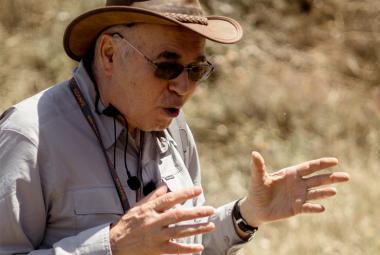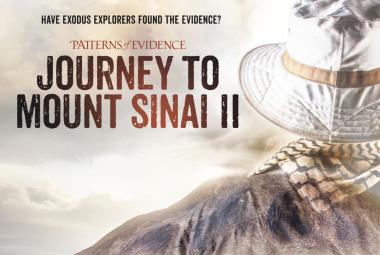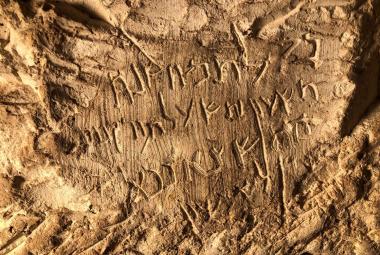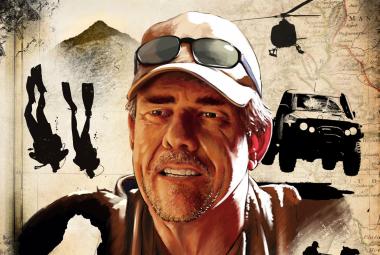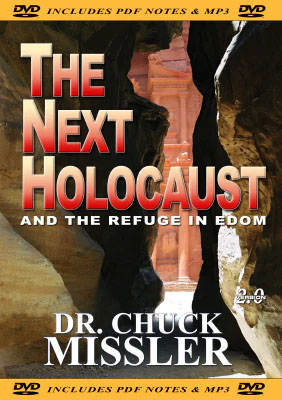On January 27, 1945, the Soviets entered Auschwitz. What they found, in this, now the best known of the Nazi death camps, were the weakest of the still living, corpses, and the remains of the vast machinery of mass murder. As the Allies approached the various camps, the Germans destroyed much of the evidence of their atrocities and forced thousands of prisoners on what became known as death marches.
Last year, we sat in the home of one of those Jewish prisoners, in Givat Shmuel, Israel. As we photographed Michael for our exhibitions, he spoke of Auschwitz and his death march. Walking through thick snow, those prisoners who fell were immediately shot in the back of the head — the roads became red with Jewish blood. When he realised he could walk no longer, he and two friends “jumped to the side” and lay face down, as though dead. Michael would, less than twenty years later, serve as special assistant to the chief prosecutor in the trial of Adolf Eichmann.1 He would be tasked with scattering in international waters, the ashes of a man responsible for the murder of forty members of his own Jewish family.
Kitia, too, was a survivor of Auschwitz - one of many modest middle class girls made to unclothe in full view of men. Stripped physically, emotionally, spiritually, “we soon looked so grotesque we couldn't recognize each other.” The Nazis developed an elaborate system of dehumanisation - hunger, torture, loss, humiliation.
Around 1.1 million were murdered at Auschwitz. When, earlier this year I photographed the only Auschwitz gas chamber left intact, I was informed by my Polish guide that it fell into disuse during the Holocaust. It was considered too slow. Seven to eight hundred naked Jews would be forced into this windowless room and Zyklon B capsules dropped from above. It took up to twenty minutes for those inside to succumb and then the burning of Jewish bodies could begin in the adjacent furnace. The industrious and disciplined German spirit led to much larger and more efficient chambers being constructed, very near the arrival and selection point in Auschwitz-Birkenau.
Auschwitz was the largest of the death camps established by the Nazis and it is unsurprising that the date of its liberation was designated, in 2005, as International Holocaust Remembrance Day.2 Auschwitz, a complex of camps less than an hour’s drive from beautiful Krakow, Poland, has become, perhaps, the symbol of the Holocaust, the systematic murder of the Jewish people. While large, this industrialised mass murder facility was only one part of the machinery constructed as a result of Europe’s determination to rid itself, once for all, of its Jews. Estimates of the number of camps and sub-camps in 1940’s Europe range between 1,200 and 15,000.
Europe’s Jewish population in the 1930's numbered some nine million. Poland was at that time home to the world's largest Jewish community. It had been so for centuries. By the time World War II ended in 1945, six million European Jews had been murdered.
Many had been reduced to ashes by those purpose built facilities in Auschwitz and elsewhere. Europe's railway network played a critical role in the destruction of Jewry. Up to four million Jews were transported by train to death factories established across Europe. Travelling for days without food or water, in overcrowded cattle cars, many perished en route. Typically a train journey lasted four days but some journeys were much longer.3 Of those who survived the rail journey, many were, within hours of arrival, gassed and incinerated.
Benjamin arrived on one of those many trains. Watching documentaries years later in his Auckland home, he was shocked to recognise himself on the arrival platform, holding the hand of the Jewish woman who had sought to comfort him on the train — he had been separated from his family. Selected by the notorious Dr Mengele for medical experimentation, he told us of another caring Jewish woman who tried to intervene when he was slow to awaken at the behest of a Nazi guard — she was shot dead on the spot. Benjamin later took her surname.
Europe of the time was considered Christian, and Germany the very pinnacle of European culture. And yet this sophisticated, highly educated society spawned an evil barely comprehensible. A story told by one of the nearly seventy Shoah4 survivors we have interviewed encapsulates this powerfully. Moshe remembers his grandfather saying “The Germans have Beethoven and Brahms. They can’t be bad people.”
Ancient hatred, German efficiency, and technology converged with theological, Darwinian and other ideologies, to destroy a people. A specific people, a particular people — or in biblical parlance a peculiar people.5
Large numbers of Gypsies, homosexuals, and other groups were also murdered by the Nazis — a fact of which one is often reminded by those who would downplay the Jewish particularity of the Holocaust. But it was Jews who were most intensively and intentionally targeted. It was Jews for whose murder Hitler was willing to divert essential resources from the front line, even in the closing stages of the war. It was Jews who were the target of a policy of complete annihilation.6
The systematic murder of Jews on an industrial scale was no historical anomaly. Rather, it was merely the worst manifestation of a hatred that for hundreds of years had simmered and frequently boiled over. A survivor we met in Kibbutz Gan Shmuel told us it was not that the Germans hated Jews more than did other Europeans. Rather, it was that others may have killed Jews with a pitch fork or their boots. Not so the Germans — they industrialised the process.
And so, to today. January 2020 will mark 75 years since the liberation of Auschwitz. Moving and elaborate ceremonies will be held in prominent cities all over the world. A veritable industry of museums, films and exhibitions has grown up around Holocaust memory.7 Surely this means Europe has atoned for its sin and that the world has learned the lessons of the Holocaust?
Sadly, apparently not.
A professional academic recently told me that Germany has been unique in its willingness to fully own its responsibility for the Holocaust. Within a month, I met two German scholars who fundamentally refuted that view. Sitting and enjoying hospitality in his Jerusalem garden, where he now makes his home, I was told by one German that his countrymen will often commemorate the Holocaust almost religiously or ritualistically. Having done so they feel in some sense absolved and more freely able to express their antisemitism in their condemnation of the Jewish state, likening the alleged mistreatment of Palestinians to the Nazi treatment of Jews.8
Thus, in a truly perverse twist, it appears that Holocaust memorialisation can lubricate antisemitism. It of course depends on the motivation of the participants. But examples exist of antisemites who have been given platforms at UN International Holocaust Remembrance Days events, allowing them later to use their participation as evidence that they could not possibly be antisemitic, despite their demonisation of the Jewish state.
Antisemitism has proven to be a most creative and resourceful hatred, always able to morph and adapt to its cultural and sociological surroundings. Dressed in the garb of human rights, antisemitism now freely parades in Western societies as anti-Zionism.9 While hatred of Jews remains uncouth, hatred of the Jewish state is in vogue.
Despite obvious and unfortunate cases of abuse, Holocaust memorialisation is more important now than ever. It is essential that the Shoah, its context, causes, victims, and perpetrators, are remembered and portrayed faithfully — particularly in the face of the onslaught of denial, distortion and universalisation.10 Our foundation11 has been involved in staging a number Holocaust remembrance events, and will be staging another in Bethlehem, Tauranga, New Zealand, on 25 January 2020.12 It will also serve as the official launch of our new exhibition entitled “Auschwitz. Now.”
Register now at www.25january2020.com
Perry Trotter is the founder of the Holocaust and Antisemitism Foundation, Aotearoa New Zealand (formerly Shadows of Shoah Trust), a non-sectarian work devoted to Holocaust memory
https://www.shadowsofshoah.com
He also engages with Christian antisemitism at: https://www.evangelicalzionism.com
Notes:
1 One of the primary architects of The Final Solution. Captured by the Israelis in 1960, Eichmann faced trial in Israel and was executed in 1962.
2 Or, United Nations International Holocaust Remembrance Day. https://encyclopedia.ushmm.org/content/en/article/international-holocaust-remembrance-day
3 The journey from Corfu is reported to have taken eighteen days. http://www.jewishwikipedia.info/transport.html
4 Hebrew: האושה, HaShoah, “the catastrophe” or Holocaust
5 Deut 26:18, 1 Pet 2:9
6 We avoid the more popular term extermination, a word normally used of vermin. Its Holocaust usage finds its source in the Nazi dehumanisation of the Jews, an essential step on the path to the ovens of Auschwitz.
7 A late friend, the son of survivors reported his mother saying: “There’s no business like Shoah business”.
8 Such comparisons are examples of violations of the IHRA working definition of antisemitism https://www.holocaustremembrance.com/working-definition-antisemitism
9 Anti-Zionism is usually antisemitic in that it tends to deny to Jews what it grants to other people groups - e.g. a right of self determination in ancestral lands.
10 https://www.shadowsofshoah.com/blog/2019/8/7/saving-the-shoah-a-brief-survey-of-denial-and-distortion
11 Holocaust and Antisemitism Foundation, Aotearoa New Zealand (formerly Shadows of Shoah Trust)
https://www.shadowsofshoah.com

